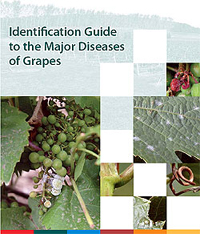
Authors:
Odile Carisse, Agriculture and Agri-Food Canada
Réjean Bacon, Agriculture and Agri-Food Canada
Jacques Lasnier, Co-Lab Recherches et Développement
Wendy McFadden-Smith, McSmith Agricultural Research Services
Note: The purpose of this guide is to help growers and advisers properly recognize diseases of grapes in Eastern Canada.
Introduction

Rapid, accurate identification of diseases in the vineyard is key to preventing serious outbreaks and losses in yield and quality. However, the presence of a pathogen or disease does not necessarily mean that a treatment is required. The severity of diseases varies from year to year, depending primarily on weather conditions, the presence of inoculum (history of the disease) and the susceptibility of the vines. This means that a disease can be devastating one year and insignificant the next. The measures to be taken to prevent losses may therefore vary from season to season.
The purpose of this guide is to aid in the identification of grape diseases and in pest management decision-making. Accurate identification of pests is critical to an effective management program that provides optimal control while minimizing pesticide use. This guide describes the major diseases of grapes in Eastern Canada.
Legend
Favourable conditions for disease development
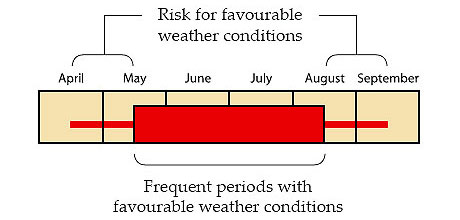
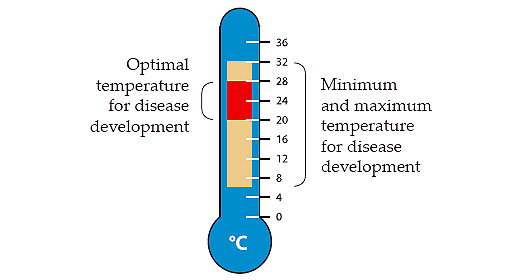



Scouting
When scouting a vineyard, bear in mind that there are several factors that can cause damage, including diseases, insects, herbicides, mammals, birds, cultural practices and abiotic factors (for example, weather). It is important not to draw premature conclusions regarding the cause of a problem and to keep in mind that more than one disease can be present at the same time. Ideally, a vineyard, regardless of whether or not it is in production, should be completely scouted, that is, all sections and all vines, at least once a week and ideally twice a week, from bud break to harvest. However this is not generally practical so special attention should be given to susceptible varieties or areas prone to disease, where the first symptoms of the disease generally appear. Well-targeted action taken early in the outbreak will generally result in improved disease control, often with less use of pesticides. Following harvest, it is important to check the condition of the vines before leaf drop (for example downy or powdery mildew sporulation) and after (for example anthracnose cankers on the cane) to assess the inoculum present on the leaves and cane at the end of the season. It is also easier to detect diseases that affect the wood of the vines after the leaves have dropped.
Examples of possible confusion during scouting
- Some diseases have similar signs and symptoms.
- A disease can have different signs and symptoms, sometimes depending on the grape variety.
- Several diseases can be present at the same time.
- Several factors, weather conditions, deficiencies, pesticides, can be present at the same time and can produce symptoms that are similar to those of diseases.
During scouting, particular attention must be paid to the following points
- Clearly identify the block, susceptibility of grape variety (Appendix 1), and vine growth stage (Appendix 2).
- Date of appearance of symptoms or damage, weather conditions before and during scouting.
- Distribution of the damage within the vineyard, for example, localized, limited to certain grape varieties or to certain parts of the vineyard, such as a depression. It is important to cover all parts of the vineyard (relief, grape variety). Knowledge of the prevailing wind direction is important for spread orientation of wind dispersed diseases like powdery mildew.
- The distribution of damage on the vine: all leaves, young or old leaves, upper side or underside of leaves, berries.
- The description of the symptoms or damage: spot, scorch, rot, wilting. Check for steel wire or any other material that could injure plant tissues.
Example of scouting record sheet, downy mildew
Block: A1
Variety: Chancellor
Date: 17/08/2004
Growth Stage: berry touch
Weather: rain, high humidity, 22-24°C
Distribution of Symptoms or Damage:
- In block: Located near the wooded area, in a depression, presence of water on the ground. Incidence: several vines, less than 1%
- On vine: Primarily at the apex of the stems (Photo 1) White sporulation on the lower leaf surface, less than 25% of the vine affected
Description of Symptoms or Damage: Infected shoot tips curl and are covered with white sporulation (Photo 2) White sporulation can be removed with the fingers
(Consult Appendix 3 for blank scouting record sheets)

Similar signs and symptoms of powdery mildew and downy mildew
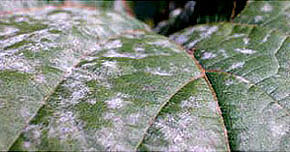
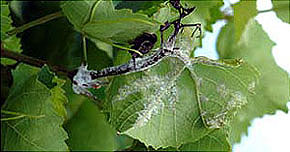
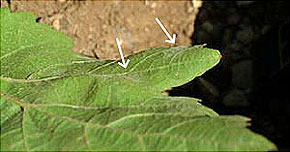

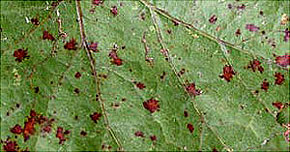
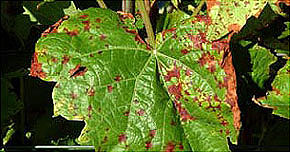

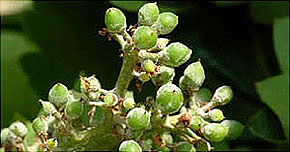
Different signs and symptoms of powdery mildew


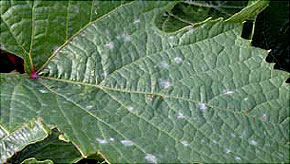



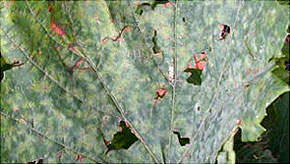

Diseases present at the same time
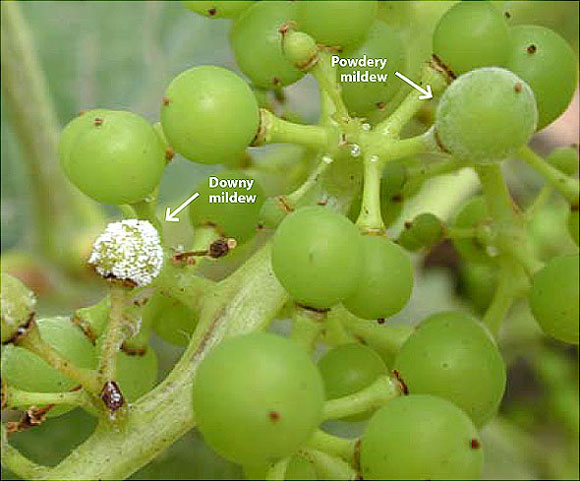
Description of the above image
Berries with both downy and powdery mildew present. Downy mildew: white varieties acquire a mottled appearance. Powdery Mildew: white spore giving them a floury appearance.
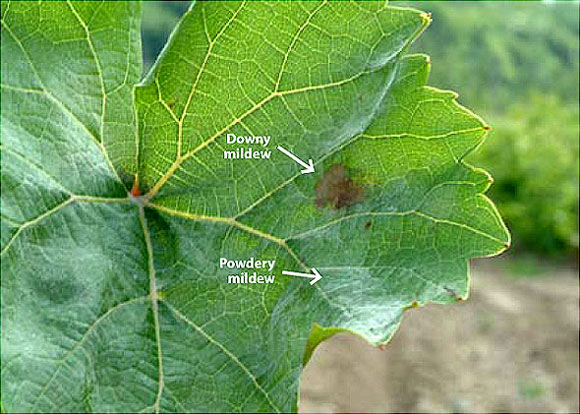
Description of the above image
Leaves with both downy and powdery mildew present.
Downy mildew: Roughly circular yellowish discolorations, called oil spots. The spots turn brown with time.
Powdery Mildew: very small orange to black spherical structures develop on the upper and lower surfaces of leaves.
Damage from different sources
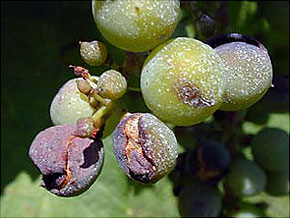
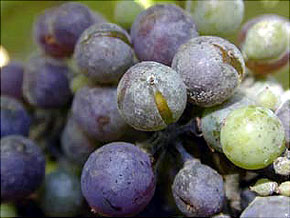
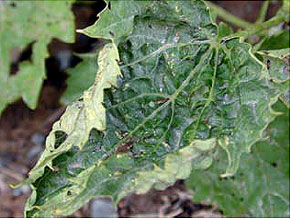
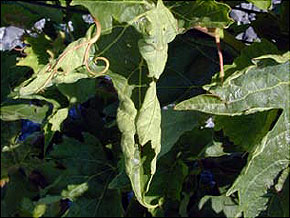


Management of grape diseases
Prevention
There are a number of factors that must be considered in selecting grape varieties. Planting varieties that are less susceptible to disease is a good way to prevent outbreaks. Orienting rows N-S and using topographical gradients will maximize air and soil drainage. Pruning debris may act as a reservoir for inoculum and should be removed and burned. Working the soil in the spring is a form of cultural control. Destroying and burying infected debris will reduce pathogen populations at the start of the season, therefore reducing the risk of disease.
Canopy management (pruning, shoot positioning, leaf removal) facilitates air circulation, which promotes drying of the leaves and increased penetration of fungicides. It is also recommended that vineyards be systematically inspected throughout the growing season to monitor the appearance and development of diseases. At harvest and at the end of the season, assess the presence of diseases like downy and powdery mildew or anthracnose on the leaves to estimate the level of inoculum that will be present the following spring.
Control
There are a number of fungicide application strategies. Where minimum risk is desired, fungicides can be applied in keeping with an established schedule rather than on the basis of observations made in the vineyard. This approach is not without its consequences on production costs and the environment. It is also possible to develop rational IPM programs for diseases of grapes. In such cases, the decision to spray is made after evaluating the consequences of this decision on production and the environment. In other words, the decision will be based on factors such as the weather conditions, the stage of development of the vine, the grape variety, parasitic pressure, etc.
Major grape diseases
Grapes are a crop that is susceptible to many diseases. However, the degree of susceptibility varies depending on the variety. When no pest management is carried out, damage can generally be severe. Downy mildew (a), powdery mildew (b), grey mold (c), anthracnose (d), black rot (e) and crown gall (f) are the major grape diseases in Eastern Canada. Anthracnose is not a problem in Ontario to date. Downy mildew, powdery mildew, grey mold, black rot and anthracnose are caused by fungi that attack the berries, reducing yield and quality. Crown gall is caused by a bacterium and can kill the plant.
The first step in an effective pest management program is correct identification of the disease. Since the severity of the damage and losses varies from year to year, the pest management program will vary depending on the weather conditions, grape variety and abundance of the pathogen.
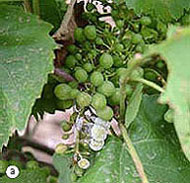


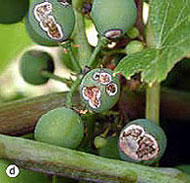
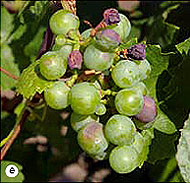
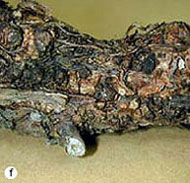
Downy mildew
Fungus: Plasmopara viticola
(Mildiou)
Symptoms
Leaves: Roughly circular yellowish discolorations, called oil spots (a). White down (sporulation of the fungus) (b), particularly on the lower leaf surface. The spots turn brown with time (c) and severely infected leaves may drop.
Shoots: Infected shoot tips curl ("shepherd's crook") (d) and a white down occurs on the stem (sporulation of the fungus) (e).
Inflorescences: The inflorescences are highly susceptible. During severe infections, they can turn yellow, brown, then dry out completely (f). They may also exhibit the cork-screwing observed in infected shoots.
Berries: White down (sporulation of the fungus) (g). Berries that exhibit sporulation when they are shot-size may shrivel and drop off. Infected berries of red varieties turn colour prematurely while those on white varieties acquire a mottled appearance. Infected berries tend to stay hard when the rest of the cluster starts to soften at veraison.
Downy Mildew Symptoms
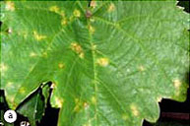
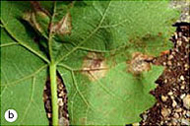
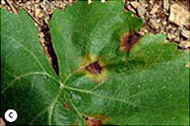

(shepherd's crook)


they can turn yellow,
brown, then dry out completely

(sporulation of the fungus)
Epidemiology
The causal fungus, Plasmopara viticola, is an obligate parasite that overwinters as oospores, or sexual spores, in dead leaves. The quantity of mature oospores in the spring is determined by the amount of precipitation the preceding fall.
In the spring, the minimum temperature for the development of the fungus is 11°C. At maturity, the oospores produce new spores (sporangia). Rain (presence of free water) then becomes the principal factor in the development of the disease. During heavy rainfall, the spores are dispersed to the leaves and fruit by water splash where they release another type of spore (zoospores, motile spores) which infect grape tissue.
Young grape tissue tends to be more susceptible to downy mildew than older tissue. Once leaves are fully expanded they tend to be less susceptible to infection. Fruit are susceptible only from bloom through 4 weeks post-bloom. However, since new succulent leaves are produced throughout the growing season, it is important to maintain good fungicide coverage for downy mildew.
Scouting
Grape varieties: Monitor susceptible varieties first.
When: From first leaf unfolded (stages 5-7), particularly during periods of rain, heavy dew and persistent fog at temperature above 11°C.
Where: Give priority to sections of the vineyard that remain wet: heavy soil, poor drainage, depression, abundant foliage. Downy mildew tends to develop on the shadiest side of the canopy first.
How: Monitor for the appearance of oil spots on the upper surface of the leaves. A white, downy sporulation that can be removed with the fingers can be seen on the lower leaf surface. Check for infected shoot tips, which bend in a "shepherd's hook", and become white with sporulation.
Early in the season, it is sometimes difficult to differentiate between downy mildew and normal "blotchiness" of young leaves. Suspected downy mildew lesions can be confirmed by placing leaves with symptoms in a plastic back with damp paper towel over night. Downy white sporulation will be evident on the underside of oilspots if it is downy mildew.
Weather conducive to disease development

Description of the above image
Environmental conditions conducive to disease development occur from early May to mid-September but are more frequent from early June to late August. The temperature range for disease development is 8 to 30°C, but the risk is highest between 22 and 26°C, particularly during periods of heavy rain accompanied by wind, heavy dew or persistent fog.
Powdery Mildew
Fungus: Erysiphe necator (Uncinula necator)
(Blanc, Oidium)
Symptoms
Leaves: The first powdery mildew lesions are frequently found on the undersides of leaves (a). As the epidemic progresses, lesions become apparent on the upper sides of leaves as well. These lesions will increase in size and number if the disease is left unchecked. Severely infected leaves may become brittle and drop off. Starting as early as late July, very small orange to black spherical structures called cleistothecia develop on the upper and lower surfaces of leaves (b).
Shoots: Brown to black irregular blotches that can measure up to a few centimetres, follow the gradual degeneration of the fungus over the course of the season (c). The spots have indistinct margins and remain visible even following shoot lignification.
Inflorescences and rachis: Usually seen on rachis, powdery mildew has the appearance of a grey to whitish powder. Severe infections of the rachis can result in clusters being dropped, especially if mechanical harvesting is done. Symptoms on the rachis are similar to those on shoots
Berries: Berries can be infected from immediately after bloom through 4 weeks post-bloom. They turn an ash grey colour and quickly become covered in spores (d), giving them a floury appearance. At the end of the season, cleistothecia also appear on the berries (e). Affected berries dry out and may drop off (f). Berries that infected later during the period of susceptibility are prone to splitting, making them susceptible to infection by Botrytis.
Powdery Mildew Symptoms


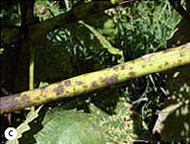

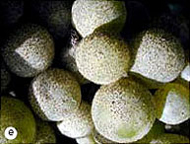
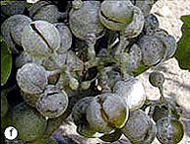
Epidemiology
E. necator is an obligate parasite of grapevines, that is, it can develop only on living grapevine tissue. In our climate, E. necator overwinters as cleistothecia, structures containing ascospores (or sexual spores). In the spring, the ascospores mature and infect the leaves growing in proximity to bark. Following infection, spots covered with asexual spores, called conidia, develop on the leaves. The conidia of E. necator do not need free water on the tissue to infect it. However, high relative humidity promotes germination of the conidia and therefore infections. Powdery mildew of grape is promoted by hot (optimum temperature of 25°C), dry (but humid) weather since water inhibits germination of the conidia.
Scouting
Grape varieties: Monitor susceptible varieties.
When: Start looking for powdery at about 3-5 leaves and continue throughout the season.
Where: Throughout the vineyard.
How: Monitor for the appearance of discolored spots that turn whitish on the upper and lower leaf surfaces. Do not confuse with pesticide residues. When checking, change the angle of the leaf. The whitish spots are particularly visible when the leaf is held at an approximately 30° angle. Be sure to sample leaves from the interior of the canopy since disease development is favoured by shade.
Weather conducive to disease development

Description of the above image
Environmental conditions conducive to disease development occur from early May to mid-September but are more frequent from mid-June to late August. The temperature range for disease development is 6 to 32°C, but the risk is highest between 20 and 28°C. Cloudy weather also increases the risk of disease development.
Anthracnose
Fungus: Elsinoe ampelina
(Anthracnose)
Symptoms
Leaves: The fungus will cause small round spots (a) which, as they age, give way to small holes (leaving a 'shot-hole' appearance) (b). During severe infections, the leaves shrivel up and drop.
Shoots: Deep elongated cankers, greyish in the centre with a black edge (c).
Inflorescences: Inflorescences are highly susceptible. During severe infections, they can turn yellow, brown, then dry out completely (d).
Berries: Deep spots, violet turning greyish in the centre, with a black edge (e). Severely infected berries dry up and drop prematurely (f, g).

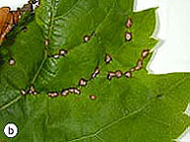
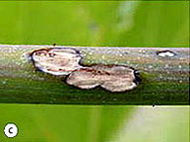


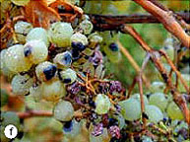
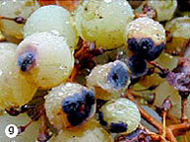
Epidemiology
The causal organism of anthracnose, Elsinoe ampelina, probably overwinters in cankers formed on the canes and in infected berries on the ground and on berries left in the trellis. In the spring, small fruiting bodies, called acervuli, form and produce spores (conidia). The spores are covered with a mucilaginous substance that enables them to stick to the site of infection. They are dispersed by rain. The longer the leaves and stems remain wet (>12 hours), the more severe the infection. The disease develops at temperatures of 10 to 35°C; the optimum temperatures for disease development are between 20 and 26°C. Symptoms appear 4 to 12 days after infection.
Scouting
Grape varieties: Susceptible varieties.
When: Particularly from stage 1st leaf unfolded (7) to stage 4-6 leaves unfolded and inflorescences visible (12). Monitor until the harvest, particularly after rainfall and storms, when the vines are wet for more than 12 hours.
Where: Entire vineyard.
How: Monitor for the presence of small black spots, particularly on young leaves.
Weather conducive to disease development

Description of the above image
Environmental conditions conducive to disease development occur from early May to mid-September but are more frequent from early June to mid-September. The temperature range for disease development is 10 to 35°C, but the risk is highest between 20 and 26°C. Rain or heavy rain conditions accompanied by wind also increase the risk of disease development.
Grey Mold
Fungus: Botrytis cinerea
(Botryotinia fuckeliana)
(Pourriture grise)
Symptoms
Botrytis cinerea is found in most fruit crops, including grapes.
Leaves: Although the most obvious symptoms are on the berries, B. cinerea can infect the green leaves and cause necrotic brown spots (a).
Inflorescences: Inflorescences can also be infected (b), causing the inflorescences to dry out or latent infections visible only at veraison.
Berries: Infected berries become covered with a greyish felt-like substance consisting of spores of the fungus (c, e). At that stage, B. cinerea is capable of directly infecting the berries (d, f), which become more susceptible as they mature and their sugar content increases.

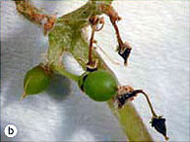



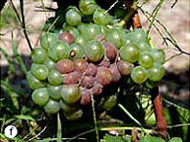
Epidemiology
The causal fungus, Botrytis cinerea, overwinters as sclerotia (compact mass of mycelium) or mycelium in plant debris. In spring, spores (conidia) form and cause lesions on young succulent grape tissues. Generally, B. cinerea requires free moisture to germinate and a wound to enter tissue. New spores are produced on the lesions. The spores are dispersed by the wind and cause several new cycles of infection, enabling the fungus to remain in the vineyard. Berries may be infected shortly after bloom but remain symptomless until veraison. Berries become more susceptible as they mature and their sugar content increases so B. cinerea is capable of directly infecting the berries without injury. When the fungus population is low, the damage generally does not result in economic losses. However, if the season is warm and wet (optimum temperatures of 15-25°C), and if grape berry moth is present, there is a greater chance of a severe infection, resulting in reduced yield and quality.
Scouting
Varieties: Particularly in susceptible varieties with very compact, thin-skinned clusters.
When: From onset of bloom (stages 19-21) and then during veraison (stages 35 and +).
Where: Entire vineyard.
How: Monitor drying out of the inflorescences and, during veraison, the presence of rotten berries with or without grey sporulation.
Weather conducive to disease development

Description of the above image
There are two periods of environmental conditions conducive to disease development: the first from late May to mid-July and the second from mid-August to late September. There are also two periods during which disease development is more frequent: the first from early June to mid-July and the second from early September to late September. The temperature range for disease development is 8 to 32°C, but the risk is highest between 16 and 26°C. Cloudy weather, rain or heavy rain conditions accompanied by wind also increase the risk of disease development.
Black Rot
Fungus: Guignardia bidwelli
(Pourriture noire)
Symptoms
All aerial parts of the plants can be infected by this disease. Black rot may have a major impact on yield if the disease is not properly controlled.
Shoots: under high disease pressure, brown to black elongated lesions with black pustules may appear.
Leaves: presence of small brown lesions (2 to 10 mm in diameter) surrounded by a darker margin, a ring of small black fruiting bodies (black pustules) (a).
Berries: At first, the berries become whitish then purple to black (b). Berries will dry and become mummified but most of the time will stay on the rachis. At the end of the season, berries will be covered by black pustules (c).
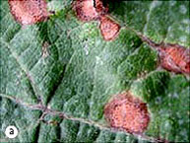
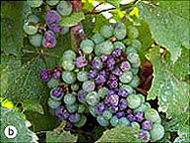
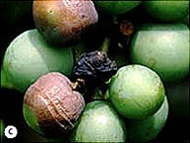
Epidemiology
The fungus overwinters in mummified berries or tendrils within the vine or on the ground as fruiting body (perithecia) containing sexual spores. In the spring, these spores will be ejected from these fruiting bodies by rain and will infect new growth. The lesions will appear about 2-3 weeks after the infection (rain) on leaves and 10 to 14 days on berries. Black fruiting bodies containing spores (secondary spores) will develop on lesions and these spores will be disseminated to all new growth, leaves, petioles, shoots, tendrils and berries causing new infections until the end of the season. Infection will occur if the wetness last at least 6 hours and the temperature is between 9 and 32°C with an optimum at 20-25°C.
Scouting
Grape varieties: Monitor susceptible varieties especially V. vinifera. Refer to the Ontario Ministry of Agriculture publication "Fruit Production Recommendations" (publication 360).
When: Black rot generally appears after downy and powdery mildew, scouting should start at the 2-3 or 4-5 fully expanded leaves (stages 9-12). Scouting should be more intense during rainy periods combined with temperatures above 9°C. The critical period for berries infection is from end of flowering to beginning of veraison.
Where: Entire vineyard.
How: Monitor for the presence of small brown lesions on leaves and fruit rot.
Weather conducive to disease development
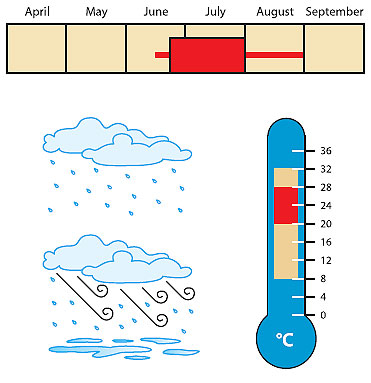
Description of the above image
Environmental conditions conducive to disease development occur from mid-June to late August but are more frequent from the third week of June to late July. The temperature range for disease development is 8 to 32°C, but the risk is highest between 20 and 28°C. Rain or heavy rain conditions accompanied by wind also increase the risk of disease development.
Crown Gall
Bacteria: Agrobacterium vitis
(Tumeur du collet)
Symptoms
Crown gall occurs in several wine producing regions. It is a serious disease because it is difficult to control and can cause the death of the vine.
Entire plant: The leaves and shoots wilt. The entire vine or only certain canes die (a).
Base and canes: Galls, more or less spherical (b). Initially, the galls are whitish, spongy to firm turning dark and brittle. The size of the galls varies. The surface of the galls is irregular and the epidermis of the stem peels (c, d, e). Galls are generally found at and just above the graft union but can develop on canes as well. Shoots and leaves may begin to wilt, especially during periods of high water demand by the vine.
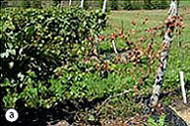
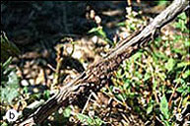
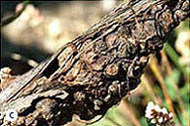
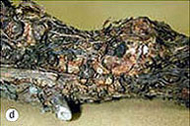

Epidemiology
The causal bacterium is often introduced into the vineyard via nursery stock. This disease is more severe in areas where winter injury is common. A. vitis can survive in the vascular system of the vines for several years without producing any symptoms. When cells are damaged by freeze injury or other factors, the bacterium invades plant cells associated with the plant's natural wound-healing process. Crown galls can take several years to appear. They develop normally at temperatures of 20 to 32°C and more slowly at temperatures of 15° and below. A. vitis is also capable of surviving for up to 5 years in root debris after infected vines have been removed.
Scouting
Grape varieties: All varieties, particularly V. vinifera.
When: At time of planting and early in the summer for vines older than one year. It is important to scout during summers that follow a very cold winter and/or a winter with little snow cover.
Where: The lowest areas of the vineyard, where frost pockets and poor soil drainage may occur.
How: Note the presence of wilting, particularly during periods of drought. A proliferation of sucker growth or aerial roots is also indicative of crown gall. Inspect the base of the plants for the presence of galls.
Weather conducive to disease development
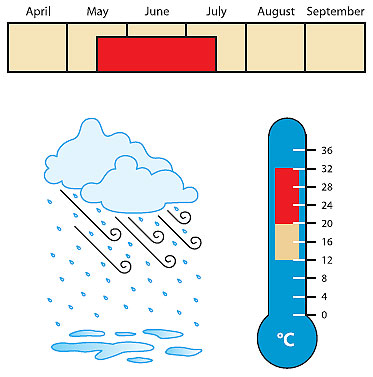
Description of the above image
Environmental conditions conducive to disease development occur frequently from mid-May to mid-July. The temperature range for disease development is 12 to 32°C, but the risk is highest between 20 and 32°C. Rain or heavy rain conditions accompanied by wind also increase the risk of disease development.
Appendix 1 - 33 Grape Varieties Susceptible to Diseases
| Grape varieties | Downy mildew | Powdery mildew | Grey mold | Black rot | Sulfur |
|---|---|---|---|---|---|
| Aurora (S5279) | ++ | +++ | +++ | +++ | No |
| Baco Noir (Baco 1) | + | ++ | + | + | No |
| Cascade (S13053) | + | ++ | ? | + | No |
| Catawba | +++ | ++ | + | +++ | No |
| Cayuga White | ++ | + | + | ? | No |
| Chancellor (S7053) | +++ | +++ | +++ | + | No |
| Chardonnay | +++ | +++ | +++ | ++ | No |
| Chelois (S10878) | + | +++ | + | + | No |
| Concord | + | ++ | + | +++ | Yes |
| DeChaunac (S9549) | ++ | +++ | ++ | + | No |
| Delaware | +++ | ++ | ++ | ++ | No |
| Dutchess | ++ | ++ | + | +++ | ? |
| Elvira | ++ | ++ | +++ | + | No |
| Eona | ? | + | ? | ? | ? |
| Foch (Marechal Foch) | + | ++ | + | + | Yes |
| Frontenac | ? | ++ | ? | ? | ? |
| Geisenheim 318 | ? | +++ | ? | ? | ? |
| Geisenheim 322 | ? | ++ | ? | ? | ? |
| Himrod | + | ++ | ? | ? | No |
| Lucy Kuhlmann | + | ++ | + | ? | ? |
| Niagara | +++ | ++ | + | ++ | No |
| Prairie Star | ? | + | ? | ? | ? |
| Riesling | +++ | +++ | +++ | ++ | No |
| Rosette (S1000) | ++ | +++ | + | ? | No |
| Rougeon (S5898) | +++ | +++ | ++ | ++ | Yes |
| Ste-Croix | + | ? | ? | ? | ? |
| Seyval Noir | ? | +++ | + | ? | ? |
| Seyval (SV5-276) | ++ | +++ | ++ | ++ | No |
| Steuben | + | + | ? | ++ | No |
| Vandal-Cliche | ++ | ++ | ? | ? | ? |
| Verdelet (S9110) | ? | ? | + | + | No |
| Vidal (V256) | + | +++ | + | ? | No |
| Vignoles (Ravat 51) | ++ | +++ | +++ | + | No |
|
Legend: Source:
|
|||||
Appendix 2 - Phenological Stages
Phenological Stages - Adapted from Eichhorn and Lorenz (1977) and Lorenz (1994)
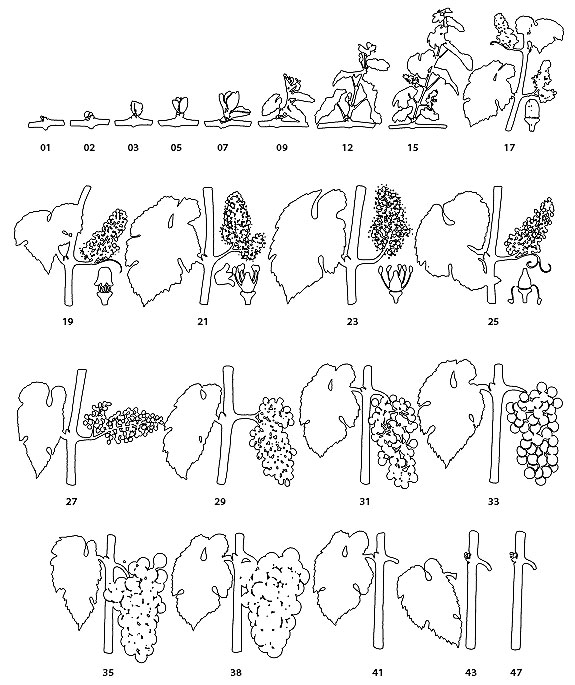
Select links below for corresponding photos
(1) Winter dormancy
(3) Wool (doeskin stage)
(5) Bud burst
(6) Green shoot
(7) First leaf unfolded
(9) 2 to 3 leaves unfolded
(12) 4 to 6 leaves unfolded, inflorescence clearly visible
(15) Inflorescence elongating; flowers closely pressed together
(17) Inflorescence fully developed; flowers separating
(19) Beginning of flowering; first caps falling
(21) Early flowering; 25% of caps fallen
(23) Full flowering; 50% of caps fallen
(25) Late flowering; 80% of caps fallen
(27) Fruit set; young fruits beginning to swell
(29) Berries small; bunches begin to hang (4-6 mm)
(31) Berries pea-sized; bunches hang (7-10 mm)
(33) Beginning of berry touch
(35) Beginning of berry ripening (veraison)
(38) Berries ripe for harvest
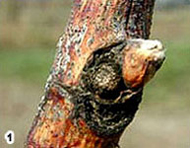



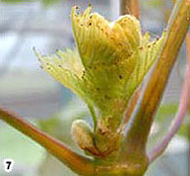


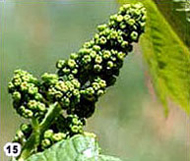
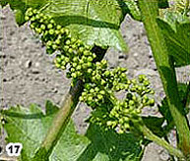

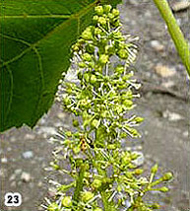

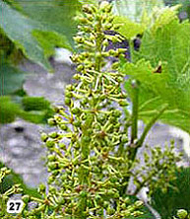

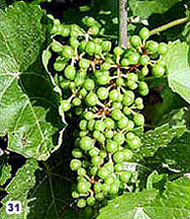
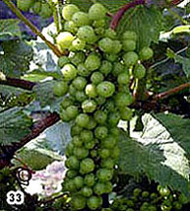

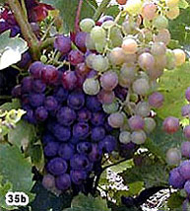
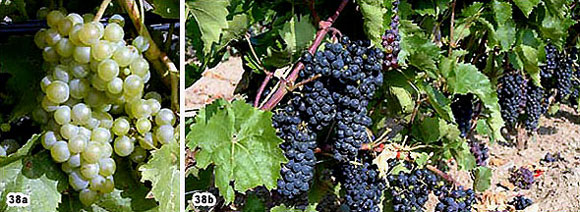
Appendix 3 - Scouting Record Sheet
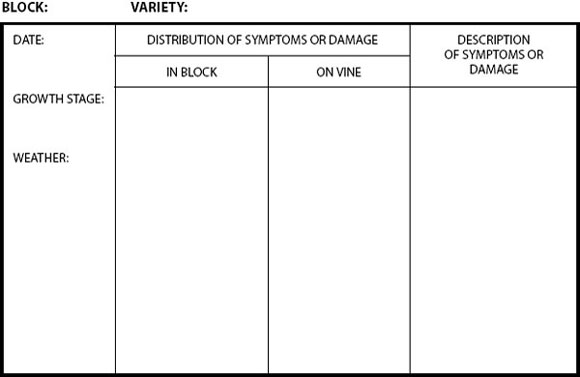
Description of the above image
Block:
Variety:
Date:
Growth Stage:
Weather:
Distribution of Symptoms or Damage - In Block:
Distribution of Symptoms or Damage - On vine:
Description of Symptoms or Damage:
Acknowledgements
- Reviewers:
- Richard Lauzier, M.A.P.A.Q.
- Ginette Laplante, M.A.P.A.Q.
- Évelyne Bariault, Duraclub
- Dominique Choquette, Club agroenvironnemental de l'Estrie
- Contributors:
- Société de Développement Économique des Régions (SDER)
- Vignoble de l'Orpailleur
- Vignoble La Bauge
- Vignoble Dietrich-Jooss
- Conception:
- Nora-Audrey Carisse-Landry
- Page layout:
- Science creative and publishing services